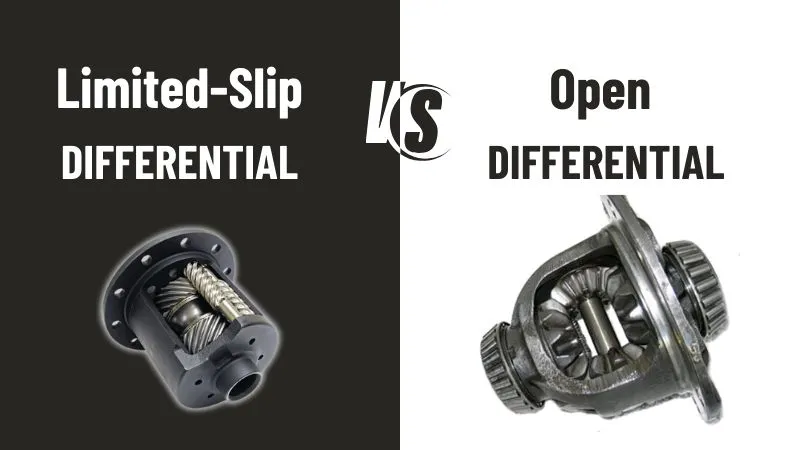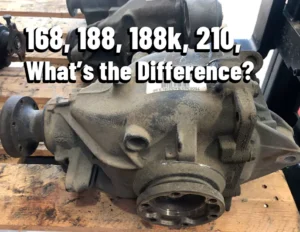Most drivers rarely think about what happens beneath the vehicle when they accelerate through a wet corner, climb a gravel slope, or launch from a stoplight. Yet deep inside the axle, a crucial component quietly determines whether the vehicle grips the road or struggles for traction—the differential. Its role is simple but essential: allowing the left and right wheels to rotate at different speeds, especially during turns. Without it, everyday driving would feel stiff, unpredictable, and unsafe.
But while all differentials serve this purpose, not all of them behave the same when traction becomes inconsistent. That is where the comparison between the open differential and the limited-slip differential (LSD) becomes especially meaningful. Their designs, performance characteristics, and behavior under pressure differ so much that choosing the right one can transform the driving experience.

What Is an Open Differential?
An open differential is the simplest and most common type found in most mass-produced vehicles. It distributes torque equally to both wheels but sends power to the wheel that meets the least resistance.
This design keeps manufacturing costs low and ensures smooth everyday driving. However, it has a major limitation:
When one wheel loses traction—such as on gravel, mud, snow, or during aggressive acceleration—the open diff transfers most of the torque to the wheel that is slipping. This results in wheel spin, reduced forward motion, and poor control.
Advantages of Open Differentials
- Smooth and predictable cornering for casual road use
- Lower production and maintenance cost
- Simple internal design with fewer components to service
- Ideal for vehicles that seldom encounter extreme traction differences
Disadvantages of Open Differentials
- Poor traction when one wheel loses grip
- Not suitable for high-performance driving or off-road conditions
- Uneven torque distribution limits acceleration stability
- Wheel spin easily occurs under heavy load
For normal city commuting, an open differential works adequately. But for performance, off-road, or heavy-duty use, its shortcomings become obvious.
What Is a Limited-Slip Differential (LSD)?
A limited-slip differential is designed to overcome the open diff’s main weakness by limiting the amount of slip between wheels. When one wheel loses traction, an LSD transfers more torque to the wheel with better grip. This dramatically improves control, stability, and acceleration.
There are several types of LSDs—clutch-type, helical (Torsen), and gear-based—but they all work toward the same purpose: balancing wheel speed without fully locking the axle.
Advantages of LSDs
- Superior traction in uneven or slippery conditions
- Improved cornering stability and exit acceleration
- Ideal for performance cars, off-road trucks, and heavy-duty applications
- Reduces wheel spin and enhances control under load
- Better power delivery when towing or carrying heavy cargo
Disadvantages of LSDs
- Higher manufacturing and maintenance cost
- More internal complexity
- May require specific lubricants
- Some designs have parts that wear over time (e.g., clutch-type)
Despite these trade-offs, the real-world benefits make LSDs the preferred choice for drivers who care about traction, performance, and driving safety.
Key Differences Between LSD and Open Differential
Below is a clear comparison to help you understand how each differential behaves under various conditions.
Traction and Grip
Open Differential:
Loses traction quickly when one wheel encounters low friction. The power goes to the slipping wheel, reducing forward motion.
LSD:
Maintains traction by redirecting torque to the wheel with grip. This keeps the vehicle stable and moving efficiently.
Cornering Performance
Open Differential:
Smooth at low speeds but unstable during high-speed corner exits due to inner wheel spin.
LSD:
Balances wheel speed, minimizing slip and allowing stronger acceleration out of corners. Crucial for track use and spirited driving.
Off-Road and Harsh Conditions
Open Differential:
Performs poorly in mud, sand, snow, and uneven terrain.
LSD:
Provides controlled torque transfer, keeping the vehicle moving even when one wheel is suspended or sliding.
Durability and Maintenance
Open Differential:
Simple design with low maintenance cost.
LSD:
More complex; some types require periodic service or specialized oils.
Cost and Accessibility
Open Differential:
Cheaper and common in most factory vehicles.
LSD:
More expensive, usually found in performance, premium, or off-road models.
Which One Is Better for Different Driving Scenarios?
Choosing the “better” differential depends entirely on how the vehicle is used.
Daily Road Driving
For everyday commuting, an open differential is sufficient. It delivers smooth performance and keeps costs low. If your driving rarely involves low-traction conditions, the benefits of an LSD may not be noticeable.
Winner: Open differential for standard commuter vehicles
Performance and Track Use
An LSD is essential for accelerating out of corners, maintaining grip during high-speed maneuvers, and ensuring balanced power delivery. Drivers seeking a more engaging and stable experience will appreciate the difference immediately.
Winner: Limited-slip differential
Off-Road and Overlanding
Uneven terrain naturally creates traction differences between wheels. An LSD prevents the vehicle from getting stuck in mild to moderate off-road conditions. For extreme situations, drivers may prefer lockers, but for versatile use, LSDs outperform open diffs significantly.
Winner: Limited-slip differential
Towing and Heavy Loads
LSDs handle weight transfer better, reducing wheel spin when carrying heavy cargo or towing up inclined surfaces.
Winner: Limited-slip differential
Different Types of LSDs and Their Uses
Limited-slip differentials are available in several designs, each offering different performance characteristics. While some older styles still exist in the market, modern applications increasingly favor gear-based mechanisms for their durability and smooth torque transfer. Below is a breakdown of the most common types and where they perform best.
Torsen (Helical Gear) LSD — The Modern, Reliable Choice
A Torsen LSD—short for “Torque Sensing”—uses helical gears instead of clutches or friction plates. This design allows the unit to distribute torque instantly and smoothly between the wheels without requiring electronic inputs or frequent maintenance. Because it reacts mechanically to differences in wheel resistance, it provides seamless traction enhancement that feels natural to the driver.
Advantages of Torsen LSDs
- Smooth, predictable torque transfer
- No clutch packs to wear out and virtually no maintenance
- Strong performance on wet pavement, gravel, light off-road terrain, and winding roads
- Highly durable design suitable for long-term use
- Excellent for performance cars, commercial vehicles, and off-road SUVs
Best Uses
Torsen units are ideal for drivers who want improved grip and stability in a wide variety of conditions without sacrificing refinement. They are particularly popular for upgraded drivetrains, OEM-level applications, and B2B customers who prioritize reliability and long service life.
Clutch-Type LSD — Older Design Still Found in Some Applications
The clutch-type LSD was once one of the most common limited-slip mechanisms. It uses friction plates to limit wheel slip, providing a more aggressive locking effect when needed. However, because these plates wear down over time, the design requires periodic servicing and does not offer the same long-term reliability as a gear-based system.
Characteristics
- Strong locking action suitable for older performance platforms
- Requires maintenance as clutch packs wear
- Less common in modern vehicles due to complexity and upkeep
Best Uses
Clutch-type LSDs are typically found in older performance cars, motorsport builds, or drivers seeking a very aggressive locking effect. However, the design is no longer the preferred choice for most modern applications.
Torque-Biasing LSDs — A Broader Category of Gear-Based Designs
Torque-biasing LSDs include several gear-based mechanisms that automatically favor the wheel with traction. While the Torsen design is the most recognized version, other variations use similar principles to manage torque distribution without relying on friction plates.
Advantages
- Smooth, maintenance-free operation
- Excellent stability during cornering
- Ideal for daily driving and dynamic road use
Best Uses
These LSDs are suitable for modern vehicles that require improved handling and traction but do not need the aggressive characteristics of clutch-based systems.
Making the Final Decision
Ultimately, the question of whether a limited-slip or an open differential is “better” comes down to intended use. The open differential remains suitable for commuting and low-demand scenarios. However, for drivers who value traction, safety, and performance, the limited-slip differential offers clear advantages that are easy to feel on the road.
Vehicles equipped with LSDs enjoy stronger acceleration, more stable cornering, and improved mobility in challenging environments. For enthusiasts, off-roaders, and commercial operators alike, the LSD is often the superior option.
If you are seeking reliable, precisely manufactured limited-slip differentials, crown wheel and pinion sets, and other drivetrain components, XJXPARTS offers factory-grade production and customization for B2B users, wholesale distributors, and automotive brands.
Our components are built to meet demanding performance standards, and we support tailored solutions for specialized applications.
You can reach us anytime through our contact page!



